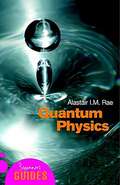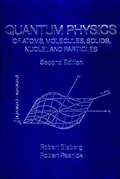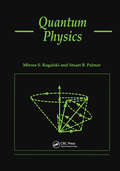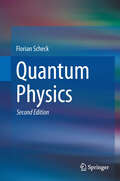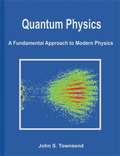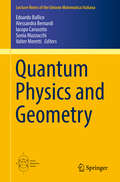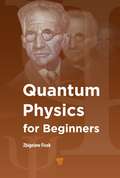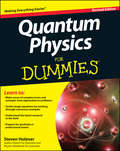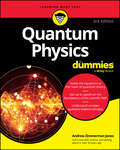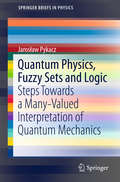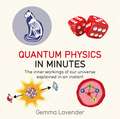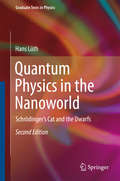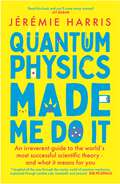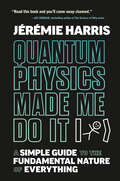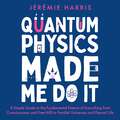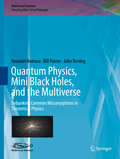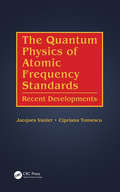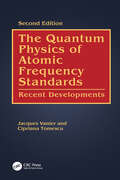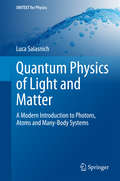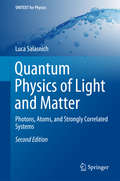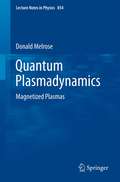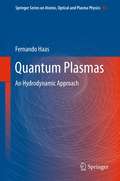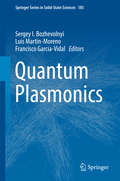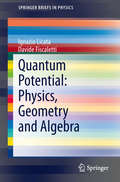- Table View
- List View
Quantum Physics: A Beginner's Guide (Beginner's Guides)
by Alastair RaeFrom quarks to computing, this fascinating introduction covers every element of the quantum world in clear and accessible language. Drawing on a wealth of expertise to explain just what a fascinating field quantum physics is, Rae points out that it is not simply a maze of technical jargon and philosophical ideas, but a reality which affects our daily lives.
Quantum Physics
by Alastair I. M. RaeOf all modern scientific theories, quantum theory has perhaps done more than any other to change the way we think about basic structure of the universe. This clear and accessible introduction covers quantum physics in theory and in practice, and explains why it has become known not just as a theory, but as a revolution.
Quantum Physics: Of Atoms, Molecules, Solids, Nuclei, and Particles
by Robert Resnick; Robert EisbergA revision of a successful junior/senior level text, this introduction to elementary quantum mechanics clearly explains the properties of the most important quantum systems. Emphasizes the applications of theory, and contains new material on particle physics, electron-positron annihilation in solids and the Mossbauer effect. Includes new appendices on such topics as crystallography, Fourier Integral Description of a Wave Group, and Time-Independent Perturbation Theory.
Quantum Physics
by Mircea S. Rogalski Stuart B. PalmerThis book presents the basic concepts and methods of quantum mechanics for upper level undergraduate students, allowing them to master its application to real physical situations. A postulate-based treatment is adopted together with a gradual development of the quantum formalism of wave functions, operators, measurement and temporal evolution. Standard topics of one-dimensional and atomic motion, angular momentum and approximation methods are presented in addition to detailed discussions of many-particle systems, atomic and nuclear radiation. Appropriate mathematical tools and techniques are provided wherever necessary. The core text is supplemented by 77 worked examples, some of which address more complex issues and aspects of present-day research. The aim is to make this textbook a realistic introduction to more advanced and specialized texts. The material provides full coverage of the subject matter, 94 problems with solutions and a further 93 with answers only
Quantum Physics
by Florian ScheckScheck's Quantum Physics presents a comprehensive introductory treatment, ideally suited for a two-semester course. Part One covers the basic principles and prime applications of quantum mechanics, from the uncertainty relations to many-body systems. Part Two introduces to relativistic quantum field theory and ranges from symmetries in quantum physics to electroweak interactions. Numerous worked-out examples as well as exercises, with solutions or hints, enables the book's use as an accompanying text for courses, and also for independent study. For both parts, the necessary mathematical framework is treated in adequate form and detail. The book ends with appendices covering mathematical fundamentals and enrichment topics, plus selected biographical notes on pioneers of quantum mechanics and quantum field theory. The new edition was thoroughly revised and now includes new sections on quantization using the path integral method and on deriving generalized path integrals for bosonic and fermionic fields.
Quantum Physics: A Fundamental Approach To Modern Physics
by John S. TownsendAn introduction to quantum mechanics and its applications with a truly innovative approach. From single-photon interference to the application of quantum mechanics to nuclear physics, Townsend's book provides a coherent picture of how the world works and how quantum mechanics can help to explain it.
Quantum Physics and Geometry (Lecture Notes of the Unione Matematica Italiana #25)
by Edoardo Ballico Alessandra Bernardi Iacopo Carusotto Sonia Mazzucchi Valter MorettiThis book collects independent contributions on current developments in quantum information theory, a very interdisciplinary field at the intersection of physics, computer science and mathematics. Making intense use of the most advanced concepts from each discipline, the authors give in each contribution pedagogical introductions to the main concepts underlying their present research and present a personal perspective on some of the most exciting open problems. Keeping this diverse audience in mind, special efforts have been made to ensure that the basic concepts underlying quantum information are covered in an understandable way for mathematical readers, who can find there new open challenges for their research. At the same time, the volume can also be of use to physicists wishing to learn advanced mathematical tools, especially of differential and algebraic geometric nature.
Quantum Physics for Beginners
by Zbigniew FicekThe textbook covers the background theory of various effects discussed from first principles, as clearly as possible, to introduce students to the main ideas of quantum physics and to teach the basic mathematical methods and techniques used in the fields of advanced quantum physics, atomic physics, laser physics, nanotechnology, quantum chemistry, and theoretical mathematics. Many of the predictions of quantum physics appear to be contrary to our intuitive perceptions, and the student will learn how it comes about that microscopic objects (particles) behave in unusual ways that are called quantum effects, what we mean by quantum, and where this idea came from. The textbook is supplemented with Problems and Solutions in Quantum Physics, which contains a wide range of tutorial problems from simple confidence builders to fairly challenging problems that provide adequate understanding of the basic concepts of quantum physics.
Quantum Physics For Dummies
by Steven HolznerQuantum Physics For Dummies, Revised Edition helps make quantum physics understandable and accessible. From what quantum physics can do for the world to understanding hydrogen atoms, readers will get complete coverage of the subject, along with numerous examples to help them tackle the tough equations. Compatible with classroom text books and courses, Quantum Physics For Dummies, Revised Edition lets students study at their own paces and helps them prepare for graduate or professional exams. Coverage includes: The Schrodinger Equation and its Applications The Foundations of Quantum Physics Vector Notation Spin Scattering Theory, Angular Momentum, and more Your plain-English guide to understanding and working with the micro world Quantum physics — also called quantum mechanics or quantum field theory — can be daunting for even the most dedicated student or enthusiast of science, math, or physics. This friendly, concise guide makes this challenging subject understandable and accessible, from atoms to particles to gases and beyond. Plus, it's packed with fully explained examples to help you tackle the tricky equations like a pro! Compatible with any classroom course — study at your own pace and prepare for graduate or professional exams Your journey begins here — understand what quantum physics is and what kinds of problems it can solve Know the basic math — from state vectors to quantum matrix manipulations, get the foundation you need to proceed Put quantum physics to work — make sense of Schrödinger's equation and handle particles bound in square wells and harmonic oscillators Solve problems in three dimensions — use the full operators to handle wave functions and eigenvectors to find the natural wave functions of a system Discover the latest research — learn the cutting-edge quantum physics theories that aim to explain the universe itself
Quantum Physics For Dummies
by Andrew Zimmerman JonesThe plain-English guide to understanding quantum physics Mastering quantum physics is no easy feat, but with the help of Quantum Physics For Dummies you can work at your own pace to unlock key concepts and fascinating facts. Packed with invaluable explanations, equations, and step-by-step instructions, this book makes a challenging subject much more accessible. Great for college students taking a quantum physics course, Quantum Physics For Dummies offers complete coverage of the subject, along with numerous examples to help you tackle the tough stuff. The Schrodinger Equation, the foundations of quantum physics, vector notation, scattering theory, angular momentum—it’s all in here. This handy guide helps you prepare for exams and succeed at learning quantum physics. Get clear explanations of the core concepts in quantum physics Review the math principles needed for quantum physics equations Learn the latest breakthroughs and research in the field Clarify difficult subjects and equations from your college courseQuantum Physics For Dummies is great a resource for students who need a supplement to the textbook to help them tackle this challenging subject.
Quantum Physics, Fuzzy Sets and Logic
by Jarosław PykaczThis Brief presents steps towards elaborating a new interpretation of quantum mechanics based on a specific version of Łukasiewicz infinite-valued logic. It begins with a short survey of main interpretations of quantum mechanics already proposed, as well as various models of many-valued logics and previous attempts to apply them for the description of quantum phenomena. The prospective many-valued interpretation of quantum mechanics is soundly based on a theorem concerning the isomorphic representation of Birkhoff-von Neumann quantum logic in the form of a special Łukasiewicz infinite-valued logic endowed with partially defined conjunctions and disjunctions.
Quantum Physics in Minutes (In Minutes)
by Gemma LavenderQuantum physics is the most fundamental -- but also the most baffling -- branch of science. Allowing for dead-and-alive cats, teleportation, antimatter, and parallel universes, as well as underpinning all of our digital technology, it's as important as it is mind-bending. This clear and compact book demystifies the strange and beautiful quantum world, and hence the nature of reality itself.Contents include: Schrodinger's cat, inside the atom, the particle zoo, the Higgs boson, Heisenberg's uncertainty principle, God playing dice, relativity, the Big Bang, dark energy and matter, black holes, the fate of the Universe, the Theory of Everything, quantum gravity, string theory, the multiverse, instant communication, quantum computing and cryptography, superconductivity, quantum biology, quantum consciousness, and much more. Written as a series of mini essays with 200 simple diagrams to help understanding, there can be no easier guide to this notoriously confusing subject. At last it's possible for non-specialists to understand quantum theory and its central role in the birth of the universe and the very existence of life.
Quantum Physics in the Nanoworld
by Hans LüthThe book deals with all essential aspects of non-relativistic quantum physics up to the quantization of fields. In contrast to common textbooks of quantum mechanics, modern experiments are described both for the purpose of foundation of the theory and in relation to recent applications. In this respect applications to nano-electronics as well as the realization of quantum-bits are presented and discussed. Furthermore, links are made to other important research fields and applications, such as elementary particle physics, solid state physics and nuclear magnetic resonance tomography in medicine. Even though the representation of the topics is largely performed in terms of Dirac´s bra-ket notation and by use of commutator algebra, the concrete description of the physical basis and the corresponding theoretical concepts are emphasized. Because of little requirement of complex mathematics, the book is suitable as an introduction into quantum physics, not only for physicists but also for chemists, biologists, engineers, computer scientists and even for philosophers as far as they are interested in natural philosophy and epistomology.
Quantum Physics Made Me Do It: A Simple Guide to the Fundamental Nature of Everything from Consciousness and Free Will to Parallel Universes and Eternal Life
by Jérémie HarrisFrom Silicon Valley entrepreneur, quantum physicist, AI risk expert, and Hollywood "alternative reality" consultant Jérémie Harris, comes an entertaining and accessible look at the world of quantum physics.The discovery of quantum mechanics has paved the way to just about every important innovation in the last half century: it has led us to the technology that powers microwaves, iPhones, and self-driving cars and is about to trigger a computing revolution that will either spell the end of the human species or propel us to heights we've never imagined. But there's another reason that quantum mechanics is so important: it is really the only way we can understand ourselves and each other. For the last hundred years or so, physicists have been feverishly debating what quantum theory has to say about you: what you're made of, whether you have free will, what will happen to you when you die, and much more. QUANTUM PHYSICS MADE ME DO IT is an amusing, irreverent exploration of the most successful scientific theory in human history, and a smart, entertaining adventure through the complex and beautiful world mapped out by modern physics.
Quantum Physics Made Me Do It: A Simple Guide to the Fundamental Nature of Everything
by Jeremie HarrisAn entertaining and accessible dive into the riveting world described by quantum mechanics, from physicist, AI risk expert, and Hollywood &“alternative reality&” consultant Jérémie Harris.Are human beings immortal? Are apples conscious? Do our legal systems make assumptions about free will that are just plain wrong? Of all the terrific books on quantum physics—from Stephen Hawking to Brian Greene—the questions they never seem to satisfy are the implications of the science. We know that quantum physics is real—our phones and computers wouldn&’t work if the science wasn&’t right. But what does it all mean?Does it mean that we live in one among a near-infinity of parallel universes? Or that everything that happens in the universe is pre-ordained—right down to what we think and how we act? Or does the science point in a stranger direction—towards the idea that the entire universe is one big mind? If one of these is true, what would it mean for our place in the universe, our immortal souls, and the future of humanity itself?The most basic encounter with quantum physics leads us to a dizzying array of incredible implications, each one more capable than the last of blowing our minds—all of which can be engaged without advanced math or deep knowledge of theory.Enter: Quantum Physics Made Me Do It—a smart, accessible, and engaging adventure through the complex and beautiful world mapped out by modern physics. Jérémie Harris at last offers us a book on quantum physics that the entire universe can enjoy—perhaps together as one big mind.
Quantum Physics Made Me Do It: A Simple Guide to the Fundamental Nature of Everything from Consciousness and Free Will to Parallel Universes and Eternal Life
by Jérémie HarrisWhat the most successful scientific theory in history teaches us about being human.From Silicon Valley entrepreneur, quantum physicist, AI risk expert, and Hollywood "alternative reality" consultant Jérémie Harris, comes an entertaining and accessible look at the world of quantum physics.The discovery of quantum mechanics has paved the way to just about every important innovation in the last half century: it has led us to the technology that powers microwaves, iPhones, and self-driving cars and is about to trigger a computing revolution that will either spell the end of the human species or propel us to heights we've never imagined. But there's another reason that quantum mechanics is so important: it is really the only way we can understand ourselves and each other. For the last hundred years or so, physicists have been feverishly debating what quantum theory has to say about you: what you're made of, whether you have free will, what will happen to you when you die, and much more. QUANTUM PHYSICS MADE ME DO IT is an amusing, irreverent exploration of the most successful scientific theory in human history, and a smart, entertaining adventure through the complex and beautiful world mapped out by modern physics.(p) 2023 Penguin Random House Canada Limited
Quantum Physics, Mini Black Holes, and the Multiverse: Debunking Common Misconceptions In Theoretical Physics (Multiversal Journeys Ser.)
by Yasunori Nomura Bill Poirier John Terning Farzad Nekoogar"Modern physics is rife with provocative and fascinating ideas, from quantum mechanics to the multiverse. But as interesting as these concepts are, they are also easy to understand. This book, written with deft hands by true experts in the field, helps to illuminate some of the most important and game-changing ideas in physics today." Sean M. Carroll "The Multiversal book series is equally unique, providing book-length extensions of the lectures with enough additional depth for those who truly want to explore these fields, while also providing the kind of clarity that is appropriate for interested lay people to grasp the general principles involved. " Lawrence M. KraussThis book explores, explains and debunks some common misconceptions about quantumphysics, particle physics, space-time, and Multiverse cosmology. It seeks to separatescience from pseudoscience.The material is presented in layperson-friendly language, followed by additional technicalsections which explain basic equations and principles. This feature is very attractiveto non-expert readers who nevertheless seek a deeper understanding of the theories,and wish to explore beyond just the basic description.Multiversal Journeys™ is a trademark of Farzad Nekoogar and Multiversal Journeys, a501 (c) (3) nonprofit organization.
The Quantum Physics of Atomic Frequency Standards: Recent Developments
by Jacques Vanier Cipriana TomescuUp-to-Date Coverage of Stable and Accurate Frequency StandardsThe Quantum Physics of Atomic Frequency Standards: Recent Developments covers advances in atomic frequency standards (atomic clocks) from the last several decades. It explains the use of various techniques, such as laser optical pumping, coherent population trapping, laser cooling, and e
The Quantum Physics of Atomic Frequency Standards: Recent Developments
by Jacques Vanier Cipriana TomescuThe Quantum Physics of Atomic Frequency Standards: Recent Developments, Second Edition, covers advances in atomic frequency standards (atomic clocks) from the last several decades. It explains the use of various techniques, such as laser optical pumping, coherent population trapping, laser cooling, and electromagnetic and optical trapping, in the implementation of classical microwave and optical atomic frequency standards.It provides an up-to-date, in-depth view of the vast improvements to atomic clocks that have occurred in the last 25 years. The improved stability and accuracy enable the verification of physical concepts used in fundamental theories, such as relativity, as well as the stability of fundamental constants intrinsic to those theories.The book first discusses improvements to conventional atomic frequency standards, highlighting the main limitations of those frequency standards and the physical basis of the limitations. It then describes how advances in the theory and applications of atomic physics have opened new avenues in frequency standards. The authors go on to explore the research and development of new microwave and optical frequency standards before presenting the results in frequency stability and accuracy achieved with these new frequency standards. They also illustrate the application of atomic clocks in metrology, telecommunications, navigation, and other areas and give some insight into future work.This new edition examines updated developments on the frequency standards, alongside content on the International System of Units (SI) and the role of atomic clocks on their base units. It also features new material on Coherent Population Trapping and new developments in the field of optical frequency standards.Key Features: Describes the basic physics, including quantum mechanics, behind the operation of atomic clocks. Explores new frequency standards that provide better stability and accuracy than older, more conventional standards. Discusses the importance of the field in the general context of physics. Jacques Vanier is retired from the National Research Council of Canada and as adjunct professor in the Physics Department at the University of Montreal. He is a fellow of the Royal Society of Canada, the American Physical Society, and the Institute of Electrical and Electronic Engineers. He has written more than 120 journal articles and proceedings papers and is the author of several books on masers, lasers, and atomic clocks. His main research work is oriented toward the understanding and application of quantum electronics phenomena.Cipriana Tomescu is retired from The Institute of Physics, Bucharest, Romania, and as invited researcher in the Physics Department at the University of Montreal. She is the author of numerous articles in scientific journals and conference proceedings. Her research involves state-of-the-art atomic frequency standards and H masers.
Quantum Physics of Light and Matter
by Luca SalasnichThe book gives an introduction to the field quantization (second quantization) of light and matter with applications to atomic physics. The first chapter briefly reviews the origins of special relativity and quantum mechanics and the basic notions of quantum information theory and quantum statistical mechanics. The second chapter is devoted to the second quantization of the electromagnetic field, while the third chapter shows the consequences of the light field quantization in the description of electromagnetic transitions. In the fourth chapter it is analyzed the spin of the electron, and in particular its derivation from the Dirac equation, while the fifth chapter investigates the effects of external electric and magnetic fields on the atomic spectra (Stark and Zeeman effects). The sixth chapter describes the properties of systems composed by many interacting identical particles by introducing the Hartree-Fock variational method, the density functional theory and the Born-Oppenheimer approximation. Finally, in the seventh chapter it is explained the second quantization of the non-relativistic matter field, i. e. the Schrodinger field, which gives a powerful tool for the investigation of many-body problems and also atomic quantum optics. At the end of each chapter there are several solved problems which can help the students to put into practice the things they learned.
Quantum Physics of Light and Matter
by Luca SalasnichThis compact but exhaustive textbook, now in its significantly revised and expanded second edition, provides an essential introduction to the field quantization of light and matter with applications to atomic physics and strongly correlated systems. Following an initial review of the origins of special relativity and quantum mechanics, individual chapters are devoted to the second quantization of the electromagnetic field and the consequences of light field quantization for the description of electromagnetic transitions. The spin of the electron is then analyzed, with particular attention to its derivation from the Dirac equation. Subsequent topics include the effects of external electric and magnetic fields on the atomic spectra and the properties of systems composed of many interacting identical particles. The book also provides a detailed explanation of the second quantization of the non-relativistic matter field, i. e. , the Schr#65533;dinger field, which offers a powerful tool for the investigation of many-body problems, and of atomic quantum optics and entanglement. Finally, two new chapters introduce the finite-temperature functional integration of bosonic and fermionic fields for the study of macroscopic quantum phenomena: superfluidity and superconductivity. Several solved problems are included at the end of each chapter, helping readers put into practice all that they have learned.
Quantum Plasmadynamics
by Donald MelroseQuantum Plasmadynamics is a synthesis of the kinetic theory of plasmas and quantum electrodynamics (QED). In this volume, the approach applied to unmagnetized plasmas in volume 1 is generalized to magnetized plasmas. First, a covariant version of nonquantum kinetic theory is formulated for single-particle (emission and scattering) processes and the collective-medium response. The relativistic quantum treatment is based on solutions of Dirac's equation for an electron in a magnetostatic field, and single-particle processes are treated using a magnetized version of QED. The response of an electron gas is derived by generalizing the derivation of the response of the magnetized vacuum.
Quantum Plasmas
by Fernando HaasThis book provides an overview of the basic concepts and new methods in the emerging scientific area known as quantum plasmas. In the near future, quantum effects in plasmas will be unavoidable, particularly in high density scenarios such as those in the next-generation intense laser-solid density plasma experiment or in compact astrophysics objects. Currently, plasmas are in the forefront of many intriguing questions around the transition from microscopic to macroscopic modeling of charged particle systems. Quantum Plasmas: an Hydrodynamic Approach is devoted to the quantum hydrodynamic model paradigm, which, unlike straight quantum kinetic theory, is much more amenable to investigate the nonlinear realm of quantum plasmas. The reader will have a step-by-step construction of the quantum hydrodynamic method applied to plasmas. The book is intended for specialists in classical plasma physics interested in methods of quantum plasma theory, as well as scientists interested in common aspects of two major areas of knowledge: plasma and quantum theory. In these chapters, the quantum hydrodynamic model for plasmas, which has continuously evolved over the past decade, will be summarized to include both the development and applications of the method.
Quantum Plasmonics
by Sergey I. Bozhevolnyi Luis Martin-Moreno Francisco Garcia-VidalThis book presents the latest results of quantum properties of light in the nanostructured environment supporting surface plasmons, including waveguide quantum electrodynamics, quantum emitters, strong-coupling phenomena and lasing in plasmonic structures. Different approaches are described for controlling the emission and propagation of light with extreme light confinement and field enhancement provided by surface plasmons. Recent progress is reviewed in both experimental and theoretical investigations within quantum plasmonics, elucidating the fundamental physical phenomena involved and discussing the realization of quantum-controlled devices, including single-photon sources, transistors and ultra-compact circuitry at the nanoscale.
Quantum Potential: Physics, Geometry and Algebra
by Ignazio Licata Davide FiscalettiRecently the interest in Bohm realist interpretation of quantum mechanics has grown. The important advantage of this approach lies in the possibility to introduce non-locality ab initio, and not as an "unexpected host". In this book the authors give a detailed analysis of quantum potential, the non-locality term and its role in quantum cosmology and information. The different approaches to the quantum potential are analysed, starting from the original attempt to introduce a realism of particles trajectories (influenced by de Broglie's pilot wave) to the recent dynamic interpretation provided by Goldstein, Durr, Tumulka and Zanghì, and the geometrodynamic picture, with suggestion about quantum gravity. Finally we focus on the algebraic reading of Hiley and Birkbeck school, that analyse the meaning of the non-local structure of the world, bringing important consequences for the space, time and information concepts.
